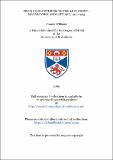From cubo-futurism to the left front : Mayakovskii and left art, 1917-1923
Abstract
In the late nineteen sixties and early seventies there was a marked upsurge of interest among Western scholars in the Soviet literary and artistic avant-garde of the nineteen twenties. The most prominent and active of Soviet avant-garde groupings was the Left Front of the Arts (Lef), led by the poet Vladimir Mayakovskii. Under his leadership, and also under the guidance of Mayakovskii's close friend, the theoretician Osip Brik, Lef stood for social commitment and called for the destruction of art. Left Front anti-art ideology stemmed from the aesthetic of pre-revolutionary cubo-futurism, a movement which had stressed experiment for its own sake and the autonomy of the artistic word. This study attempts to show the process of transformation of cubo-futurist ideas, in particular by examining Mayakovskii's works and his activities from the February revolution in 1917' the launching of the magazine LEF in 1923. Mayakovskii willingly placed his pen at the service of the revolution. He also believed fervently that- only through the experimentalism of the avant-garde could truly revolutionary art be created in Soviet Russiac. And so Mayakovskii came to play a leading role in the avant-garde, the so-called 'left'' artists, both as a writer and as a propagandist and organiser. Only slightly less important was the part played by Osip Brik whose theories firstly of 'art as device' and subsequently of the 'social command' were to have a great impact on the development of Mayakovskii's verse. For almost three years after the October revolution of 1917, the 'left' artists were able, faut de mieux, to occupy leading positions in the country's artistic life. Initially experimentalism was equated with the revolutionary in art, Brik, however, was to go further, looking to a connection of art with (to) productive forces, to the creation of a new industrial aesthetic. The 'left' expended much energy laying claim to the title of proletarian art. Such claims were vigorously resisted organisations such as the Proletkul't and by the Party. By the end of 1920 the power of the 'left' had been effectively broken. In his efforts to get his own work published Mayakovskii, too, fell victim to official displeasure. Mayakovskii's verse of this period shows very clearly the influence of the ideas developed by Brik. This is clear from the programmatic poems, as also from the themes and form of his agitational verse. In these last, Mayakovskii expressed his commitment to the Soviet regime, but in many of the lyrical pieces written at this time the signs of deep inner doubts are unmistakeable. Similar developments to those taking place in Moscow were to be found in the Far East, where a group of futurists called 'Tvorchestvo' strove to put the new art forms at the service of the revolution. When the members of this group made their way back to Moscow late in 1921, they joined forces with Mayakovski and the remnants of the pre-revolutionary cubo-futurist movement, which had also been dispersed by the revolution and the civil war. Mayakovskii now hoped to lead a movement which would finally demonstrate the necessity for formally revolutionary art in a revolutionary society; art that would seek to work directly on the masses and their environment. He was to be disappointed.
Type
Thesis, MPhil Master of Philosophy
Collections
Items in the St Andrews Research Repository are protected by copyright, with all rights reserved, unless otherwise indicated.

